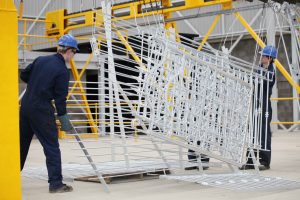There is a perception that hot dip galvanizing is a very time consuming process that takes weeks, not days, to be completed. The reality is quite different.

The actual process of dipping steel in molten zinc takes just a matter of minutes. What takes a bit longer is the preparation beforehand. The steel must be hung on jigs, cleaned, rinsed and fluxed before it can be galvanized. Afterwards, it must cool (the galvanizing bath is at about 450°C) and be taken off the jigs. The time to do all of this is only a few hours. In practice of course, there is a lot of other work being processed too, so the typical turnaround time is about three days.
By arrangement, it may even be possible to do it in 24 hours.
All these operations take place in a factory environment which is unaffected by the weather. When the work has cooled after galvanizing the process is complete. The coating does not have to cure or dry out and it will not change its hardness. This means that the steelwork can go directly to site and be erected. The coating will normally resist the knocks and bangs of site handling that could seriously damage other types of coating.
factory environment which is unaffected by the weather. When the work has cooled after galvanizing the process is complete. The coating does not have to cure or dry out and it will not change its hardness. This means that the steelwork can go directly to site and be erected. The coating will normally resist the knocks and bangs of site handling that could seriously damage other types of coating.
So what can the customer do to minimise turnaround- time?
Four things, none of which are very difficult:
- Ask about the workload of the galvanizer. This varies from day to day and season to season – by phoning a few days beforehand work can be planned into the schedule.
- Send in ‘clean’ steelwork. Like all protective finishes, galvanizing depends upon good surface preparation. Work that is contaminated with material which will not be removed by the normal. galvanizing pre-treatment will need special steps to remove it, which takes time. So remove paint or grease, before the steelwork is sent to be galvanized.
- Put the correct vent and drain holes in hollow steelwork. Being a dip process, galvanizing will protect the inside of steel sections as well as the outside – providing these holes are in the right places. These holes are essential for safe and effective galvanizing – so the galvanizer will have to put them in – which takes time.
- Save on transport time. If the galvanizer is providing transport, liaise about the regular runs and plan around them. The galvanized steelwork may even be able to go directly to site.
Galvanizing is a quick process that can save time and money.
